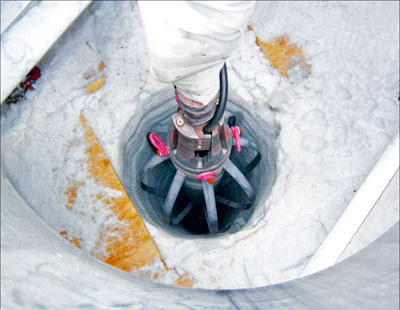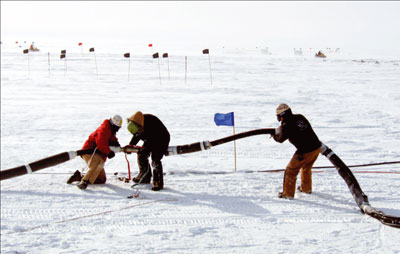Deep in the ice at the South Pole, the IceCube detector is now fully functioning after six years of challenging construction.

Image credit: Jim Haugen.
On 18 December 2010, just after 6 p.m. New Zealand time, seven austral summers of construction came to an end as the last of 86 optical sensor strings was lowered into the Antarctic ice – IceCube was complete, a decade after the collaboration submitted the proposal. A cubic kilometre of ice has now been fully instrumented with 5160 optical sensors built to detect the Cherenkov light from charged particles produced in high-energy neutrino interactions.
The rationale for IceCube is to solve an almost century-old mystery: to find the sources of galactic and extragalactic cosmic rays. Neutrinos are the ideal cosmic messengers. Unlike charged cosmic rays they travel without deflection and, as they are weakly interacting, arrive at Earth from the Hubble distance. The flip side of their weak interaction with matter is that it takes a very large detector to observe them – this is where the 1 km3 of ice comes in. The IceCube proposal argues that 1 km3 is required to reach a sensitivity to cosmic sources after several years of operation. This volume will allow IceCube to study atmospheric muons and neutrinos while searching for extra-terrestrial neutrinos with unprecedented sensitivity.
How it works

Image credit: IceCube
The concept is simple. A total of 5160 optical sensors turn a cubic kilometre of natural Antarctic ice into a 3D tracking calorimeter, measuring energy deposition by the amount of Cherenkov light emitted by charged particles. Each sensor is a complete, independent detector – almost like a small satellite – containing a photomultiplier tube 25 cm in diameter, digitization and control electronics, and built-in calibration equipment, including 12 LEDs.
Designing these digital optical modules (DOMs) was not easy. As well as the requirement for a high sampling speed of 300 million samples a second and a timing resolution better than 5 ns across the array (the actual time resolution is better than 3 ns), the DOMs needed to have the reliability of a satellite but on a much smaller budget. They were designed with a 15-year lifetime and operate from room temperature down to –55 °C, all the while using less than 5 W. This power per DOM may not sound like much, but it mounts up to about 10 planeloads of fuel a year. Nevertheless, the design was good, and 98% of the IceCube DOMs are working perfectly, with another 1% usable. Since the first deployments in January 2005, only a few DOMs have failed, so the 15-year lifetime should be met easily.

Image credit: Jim Haugen.
Building the DOMs was only the first challenge. Because the shallow ice contains air bubbles, the DOMs must be placed deep, between 1450 and 2450 m below the surface. The sensors are deployed on strings, each containing 60 DOMs spaced vertically at 17 m intervals. Pairs of DOMs communicate with the surface via twisted pairs that transmit power, data, control signals and bidirectional timing calibration pulses. The 78 “original” strings are laid out on a 125 m triangular grid, covering 1 km2 on the surface. The remaining eight strings are then placed in the centre of IceCube, with a dense packing of 50 high-quantum-efficiency DOMs covering the bottom 350 m of the detector. This more densely instrumented volume, known as DeepCore, will be sensitive to neutrinos with energies as low as 10 GeV, which is an order of magnitude below the threshold for the rest of the array.
The key to assembling the detector was a fast drill. Hot water does the trick: a 200 gal/min stream of 88ºC water can melt a hole 60 cm in diameter and 2500 m deep in about 40 hours. It takes another 12 hours to attach the DOMs to the cable and lower them to depth. This proved fast enough to drill 20 holes in roughly two months.
Speed was vital because the construction season is necessarily short in this region – the Amudsen-Scott South Pole Station is accessible by plane for only four and a half months a year. Add the time to set up the drill at the start of the season and take it down at the end, and less than two months are left for drilling.
This brief description does not do justice to the host of difficulties faced by the construction crew. First, hot water drills are not sold at hardware stores – many human-years of effort went into developing a reliable, fuel-efficient system. Second, the South Pole is one of the least hospitable places on Earth. Every piece of equipment and every gallon of fuel is flown in from McMurdo station, 1500 km away on the Antarctic coast. The altitude of 2800 m and the need to land on skis limited the cargo that could be carried: everything had to fit inside an LC130 turboprop plane. The weather also complicates operations. Typical summer temperatures are between –15 °C and –45 °C, which is hard on both people and equipment. The need for warm clothing further exacerbates the effect of the high altitude; many tasks become challenging when you are wearing thick gloves and 10 kg of extreme cold weather gear.
Against the odds

Nevertheless the collaboration succeeded. From the humble single string deployed in 2005 (and, incidentally, adequate by itself to see the first neutrinos), construction ramped up every year, reaching a peak of 20 strings deployed during the 2009/2010 season. This was good enough to allow for a shorter season this final year, leaving time to clean up and prepare the drill for long-term storage.
Even though IceCube has just been completed, the collaboration has been actively analysing data taken with the partially completed detector. This is also no simple matter. Even at IceCube’s depths, there are roughly a million times as many downwards-going muons produced in cosmic-ray air showers as there are upwards-going muons from neutrino interactions in the rock and ice below IceCube. To avoid false neutrino tracks, IceCube analysers must be extremely efficient at avoiding misreconstructed events. Worse still, IceCube is big enough to observe two or more muons, from different cosmic-ray interactions, simultaneously. Still, with stringent cuts to reject background events, it is possible to select an almost pure neutrino sample. In a one-year sample, taken with half of the full detector, IceCube collected more than 20 000 neutrinos. This sample was used to extend measurements of the atmospheric neutrino spectrum to an energy of 400 TeV. The events are being scrutinized for any deviation from the anticipated flux that would mean evidence of new neutrino physics or, on the more exotic side, deviations in neutrino arrival directions that could signal a breakdown of Lorentz invariance or Einstein’s equivalence principle.

With the 40-string event sample the collaboration has produced a map of the neutrino sky that has been examined for evidence of suspected cosmic-ray accelerators. None have been found, although it is important to realize that at this stage no signal is expected at a significant statistical level. For instance, we have reached a sensitivity that can observe a single cosmogenic neutrino for the higher end of the range of fluxes calculated. We have also started to probe the neutrino flux predicted from gamma-ray bursts, assuming that they are the sources of the highest-energy cosmic rays.
The first surprise from IceCube does not involve neutrinos at all. IceCube triggers on cosmic-ray muons at a rate of about 2 kHz, thus collecting billions of events a year. These muons have energies of tens of tera-electron-volts and are produced in atmospheric interactions by cosmic rays with energies of hundreds of tera-electron-volts, i.e. the highest-energy Galactic cosmic rays. A skymap of well reconstructed muons with an average energy of 20 TeV reveals a rich structure with a dominant excess in arrival directions pointing at the Vela region. These muons come from cosmic rays with energies of many tens to hundreds of tera-electron-volts; the gyroradiius of these particles in the microgauss field of the galaxy is in the order of 0.1 parsec, too large to be affected by our solar neighbourhood. However, these radii are too small to expect that the cosmic rays would point back even to the nearest star, never mind a candidate source like the Vela pulsar or any other distant source remnant at more than 100 parsec.
Either we do not understand propagation in the field, or we do not understand the field itself
There is some mystery here: either we do not understand propagation in the field, or we do not understand the field itself. Does the detector work? Definitely: we observe in the same data sample the Moon’s shadow in cosmic rays at more than 10 σ, as well as the dipole resulting from the motion of the Earth around the Sun relative to the cosmic rays.
Additionally, IceCube has established the tightest limits yet on the existence of dark matter, which consists of weakly interacting massive particles that have spin-dependent interactions with ordinary matter. In the alternative case – dominant spin-independent interactions – IceCube’s limits are almost competitive with direct searches. In addition, by monitoring the signal rates from its photomultiplier tubes, IceCube will be sensitive to million-electron-volt energy neutrinos from supernova explosions anywhere in the galaxy.
Looking forward
Now the 220-strong IceCube collaboration – with members from the US, Belgium, Germany, Sweden, Barbados, Canada, Japan, New Zealand, Switzerland and the UK – is eagerly looking forward to analysing data from a complete and stable detector. Analysing and simulating data from an instrument that changed every Antarctic season has been a challenge.

Image credit: Jon Dumm.
At the same time, neutrino astronomers are thinking about the future. Even IceCube is too small to collect a significant number of events at the highest energies. This has already been pointed out in the case of cosmogenic neutrinos with typical energies in excess of 106 TeV. These are produced when ultra-high-energy cosmic rays interact with photons in the cosmic microwave background. To observe these neutrinos requires a much larger detector. Physicists are aiming for a volume of 100 km3. This will require a new technology, and several groups are already deploying antennas to observe the brief coherent radio Cherenkov pulses emitted by neutrino-induced showers. The advantages of radio detection are that the signal is coherent, so it scales as the neutrino energy squared. Also, the radio signals have larger attenuation lengths than light, allowing detectors to be placed on a 1 km, rather than 125 m, grid. The cost is that radiodetectors have energy thresholds that are much higher than IceCube.








